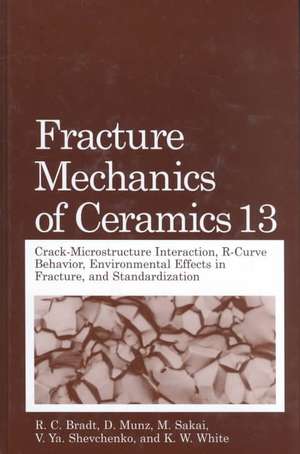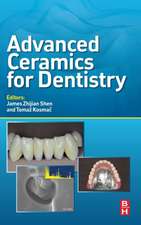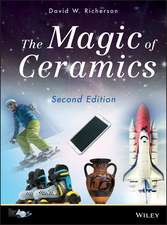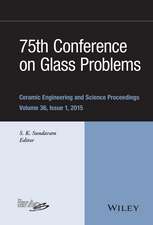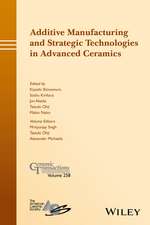Fracture Mechanics of Ceramics: Volume 13. Crack-Microstructure Interaction, R-Curve Behavior, Environmental Effects in Fracture, and Standardization
Editat de R.C. Bradt, D. Munz, M. Sakai, V.Ya. Shevchenko, K.W. Whiteen Limba Engleză Hardback – 27 feb 2002
| Toate formatele și edițiile | Preț | Express |
|---|---|---|
| Paperback (1) | 1234.46 lei 6-8 săpt. | |
| Springer Us – 30 noi 2010 | 1234.46 lei 6-8 săpt. | |
| Hardback (1) | 1242.83 lei 6-8 săpt. | |
| Springer Us – 27 feb 2002 | 1242.83 lei 6-8 săpt. |
Preț: 1242.83 lei
Preț vechi: 1515.65 lei
-18% Nou
Puncte Express: 1864
Preț estimativ în valută:
237.82€ • 254.31$ • 198.29£
237.82€ • 254.31$ • 198.29£
Carte tipărită la comandă
Livrare economică 18 aprilie-02 mai
Preluare comenzi: 021 569.72.76
Specificații
ISBN-13: 9780306466632
ISBN-10: 0306466635
Pagini: 530
Ilustrații: X, 530 p.
Dimensiuni: 178 x 254 x 30 mm
Greutate: 1.17 kg
Ediția:2002
Editura: Springer Us
Colecția Springer
Locul publicării:New York, NY, United States
ISBN-10: 0306466635
Pagini: 530
Ilustrații: X, 530 p.
Dimensiuni: 178 x 254 x 30 mm
Greutate: 1.17 kg
Ediția:2002
Editura: Springer Us
Colecția Springer
Locul publicării:New York, NY, United States
Public țintă
ResearchDescriere
This Volume 13 of the Fracture Mechanics of Ceramics series constitutes the th Proceedings of the 7 International Symposium on the fracture mechanics of ceramics held at the Presidium of the Russian Academy of Sciences, Moscow, Russia on July 20 to 22, 1999. The series started from the Proceedings of the 1 st Symposium at the Pennsylvania State University that has been held on 1973 (Vols. 1 and 2), followed by 1977 and 1981 Years meetings (Vols. 3 to 6) which were held at the Pennsylvania State University, too. Volumes 7 and 8 are from the 1985 Symposium which was held at the Virginia Polytechnic Institute and State University, Volumes 9 and 10 are from the 1991 Symposium at Japan Fine Ceramic Centre, Nagoya, and Volumes 11 and 12 are from the 1995 Symposium at Kernforschungszentrum, Karlsruhe. The theme of the Symposium was focused on the mechanical behaviour of advanced ceramics in terms of the cracks, particularly the crack-microstructure interaction, delayed failure, environmental effects in fracture. Special attention was paid on the novel methods in fracture mechanics testing, pre-standardisation and standartisation. The authors from 19 countries represented the current state of that field. The International Scientific Committee gratefully acknowledge the sponsoring provided by The Russian Academy of Sciences and, personally, Academician Yu.S.Osipov, President of RAS; The Ministry of Science and Technologies of the Russian Federation, Prof. G.Terestchenko; Russian Foundation for Basic Research, Academician I.Moiseev; Scientific Technical Center "Bacor", Dr. B.Krasnij; Gzhel Ltd., Prof.
Cuprins
Calculation of Crack Tip Phase Transformation Zones in TZP with the Weight Function Method; G. Rauchs, et al. Stress and Strain Fields near a Crack Tip in Damaged Solids; E.V. Lomakin. `Ultra'-Fast Fracture Strength of Advanced Structural Ceramics at Elevated Temperatures: an Approach to High-Temperature `Inert' Strength; S.R. Choi, J.P. Gyekenyesi. Internal Residual Stresses in Ceramics Materials: Stress Fluctuations near a Crack Tip and Effective Energy Release Rate; V.A. Buryachenko. Theoretical Investigation of Fracture Behaviour in Ferroelectric Ceramics; M. Kuna, A. Ricoeur. Brittle Growing Criteria for Cracks in Structurally Ordered Porous Media with Mesodamages; V.V. Adishchev, et al. Designing Residual Stress Profiles to Produce Flaw-Tolerant Glass; D.J. Green, et al. Multiscale Discrete-Integral Strength Criteria. Satellite Nucleation of Microcracks; V.M. Kornev. Influence of Near-Surface Residual Stresses on Strength of Ceramics; T. Fett, D. Munz. Heat Treatment Induced Changes in Fracture Behaviour of Bulk Plasma Sprayed Alumina; R.J. Damani. Improvement of the Strength of Silicon Nitride by Aging; T. Lube. Application of the Brazilian Disc Test for Strength Measurements on Ceramic Green Bodies; M. Hangl, et al. Analysis of Residual Stress State in Thermal Barrier Coatings; T.-J. Chuang, E.R. Fuller, Jr. Damage Development upon Creep Test in Ceramic Matrix Composites; S. Darzens, et al. Determination of Fracture Toughness of SiC-Whiskers Reinforced Si3N4 by Two Different Techniques; P. Bosetti, V.M. Sglavo. Fracture Toughness and Work of Fracture of SiC-Fibre Reinforced Glass Matrix Composite; I. Dlouhyý, et al. R-Curve Effect on Slow Crack Growth and Thermal Shock of Ceramics; G. Fantozzi, et al. The Relation between the DamageTolerance and the R-Curve Behavior of Alumina Ceramics; S. Sakaguchi. Effect of Environment on Delayed Failure in a Glass-Bonded Alumina; S.M. Barinov, et al. R-Curve Effect and Process Zone in Coarse Grained BaTiO3; A. Förderreuther, et al. Cyclic Fatigue of Zirconia Ceramics; M. Anglada, et al. Effect of Grain Size on Crack Growth in Alumina; M.E. Ebrahimi, et al. Slow Crack Growth in Zirconia Ceramics with Different Microstructures; J. Chevalier, et al. Measurement of Fatigue Limit in Silicate Glasses; V.M. Sglavo, D.J. Green. Fatigue Damage Accumulation Mechanisms in Monolithic Alumina; R.D. Geraghty, et al. Strength Behaviour of a Gas Pressure Sintered Siliconnitride (GPSSN) under Static and Cyclostatic Loading at 1250°C in Air; S.S. Schmauder, et al. High Temperature Deformation and Internal Friction in Silicon Nitride Ceramics; P. Hvizdoš. Structure and High-Temperature Creep of Oxide Ceramics Properties of Diffusion Path and their Influence on Creep; V.S. Bakunov, A.V. Belyakov. Thermal Shock Strength and Thermal Shock Fracture Toughness of Ceramics; H. Awaji, et al. Thermal Shock and Thermal Fatigue of Alumina Ceramics; M. Saâdaoui, et al. Fracture Kinetics of Thermally Loaded Bodies in Elastic-Brittle State and Criterion of Thermal Stress Resistance; A.G. Lanin, V.S. Egorovo. Pre-Standardization and Standardization Activity of ISO/TC 206 Committee. Status of ISO/TC 206 on Fine Ceramics; T. Kanno. Fracture Toughness of Ceramics Using the SEVNB Method a Joint VAMAS/ESIS Round Robin; J. Kübler. A Knoop-Indentation Method for R-Curve Determination; T. Lube. Hardness of Titanium Carbide Thin Films Deposited on Silicon by Laser Ablation; G. De Maria, et al. The SB (Sandwiched Beam) Technique for Pre-Cracking Brittle Materials; E. Trentini, V.M.
